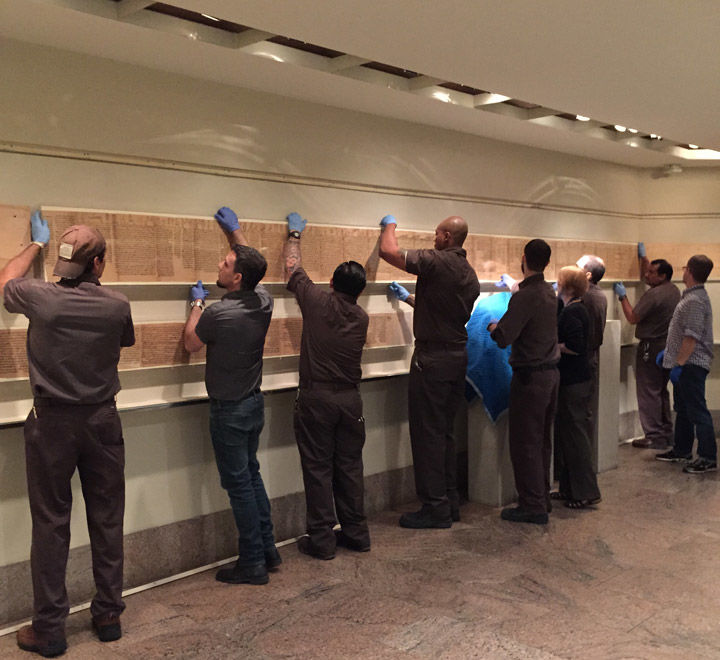
Riggers and technicians deinstalling a section of the Book of the Dead of the Priest of Horus, Imhotep in June 2015. Photo by the author
In preparation for the renovation of the Ptolemaic galleries of Egyptian art, riggers and technicians deinstalled one of the most-viewed objects at The Met, the Book of the Dead of the Priest of Horus, Imhotep, and its companion, Papyrus inscribed with six "Osiris Liturgies".
The two scrolls are housed in eight framed sections, measuring around
100 feet in total length, in gallery 133. For the staff of the
Department of Egyptian Art and myself, an associate paper conservator,
this step represented the start of the second phase of the refurbishment
of the scrolls' display.The first phase began many months earlier and involved looking at a lot of shop drawings from the vendors we contract with to build cases and frames. Reading shop drawings is not my forte, but it's important for conservators to be involved in the design process to ensure that all the materials used, including the lighting, meet archival standards for preservation. With our knowledge of the materiality of the object, we help plan mounting solutions that provide proper structural support, which are especially needed for an object as fragile as a papyrus scroll.
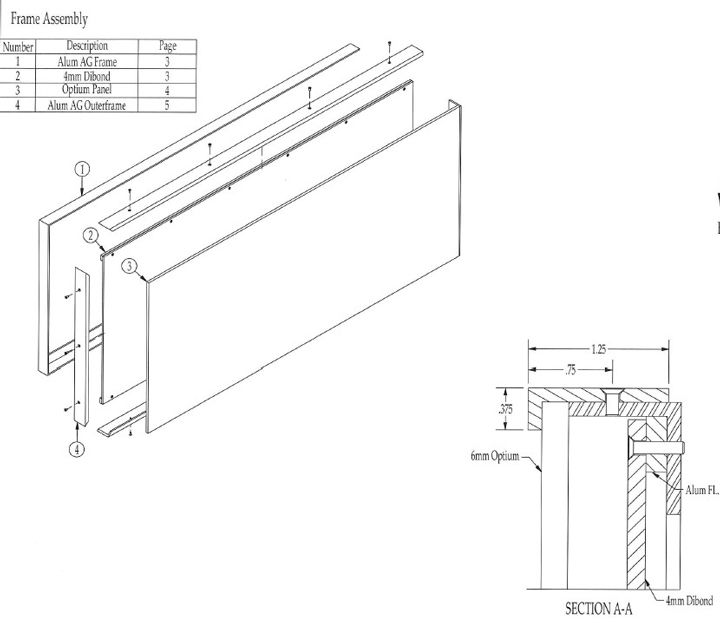
A shop drawing for the frame package. Image courtesy of Smallcorp
For this project, we had to think about how the papyrus would be
transferred to the new mount and how the mounts and frames would be
installed in the cases, a logistical challenge due to the fact that
several of the sections are 20 feet long. Ultimately, we decided on
frame designs that would allow us to keep the original backings that the
papyrus sections were mounted to. The original plexiglass frames were very old, and we suspected that the plexi had embrittled and become vulnerable to cracking during handling. To our knowledge, the frames had never been removed from the old wall case. I also did not have any documentation on the condition of the scrolls or how they were mounted to their backings, although we were able to deinstall one of the smaller frames, open it up, and examine the scroll to make inferences about the rest of the sections. As we approached the deinstallation of the scrolls, we had a lot of questions that could not be answered until we jumped in and got started!
The Department of Egyptian Art prepared their storeroom with long shelves to store the scrolls. We immediately got to work transferring the scrolls on their old backings to the new frames, starting with a short section, the beginning of the scroll. Smooth sailing! Until we tried the next section, which measured around 20 feet long.
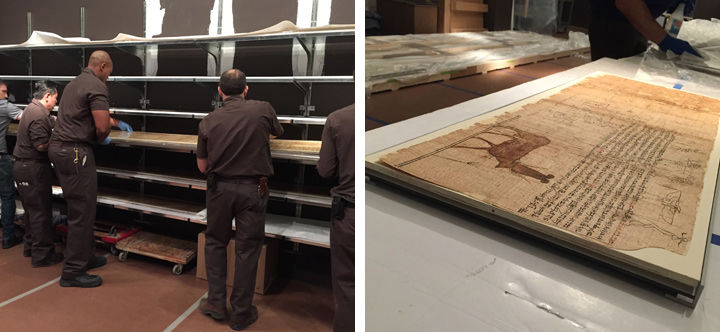
Left: Riggers placing a frame section on the Egyptian storeroom shelves. Right: The first section of the Book of the Dead in its new frame. Photos by the author
During the deinstallation process, we could see how incredibly
fragile the old plexi frames were, so The Met's carpentry shop
fabricated a massive cradle that could support the frames as they were
moved on and off the shelves, and our technicians used a system of dual
lifts to raise and lower them onto our work tables.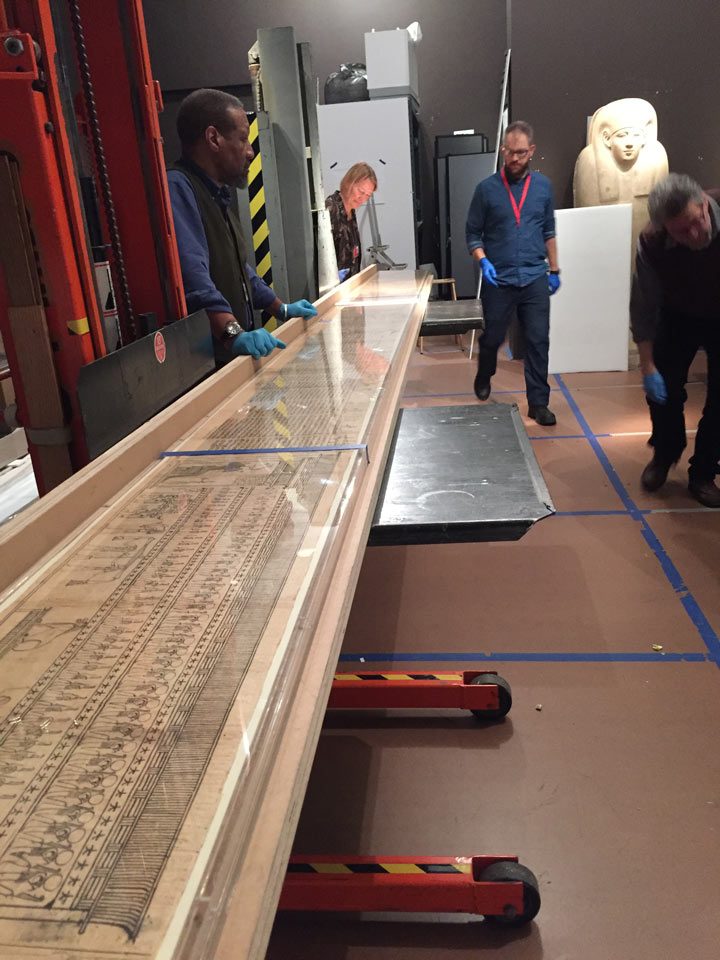
Departmental Technicians Tim Dowse, Charles
Dixon, and John Morariu and Curator Catharine Roehrig contemplating
moving a long section of the scroll that is supported by a wooden cradle
and two pneumatic lifts. Photo by the author
So far, so good until. . . the old mounts for the long sections did
not fit in the frames. We all visited each of the five stages of grief,
arriving finally at acceptance of the fact that the scrolls would have
to be remounted onto new backings specifically made by our conservation
matter and framer to fit the new frames.Despite the risks involved in transferring the loose papyrus scrolls to new backings, there were also benefits: for one, the new backings would be made of fresh acid-free rag board, ultimately providing an extended and better period of preservation of the scrolls. Additionally, as I was already mounting all the scrolls to the new backings, I incorporated the time to make some needed repairs and to stabilize the papyrus. There was no way we could flip the long scroll over to get to the back, so repairs had to be slipped behind the papyrus as it was face up, using a piece of silicon-impregnated parchment paper to make sure the tissue did not stick to the backing.

Before (left) and after (right) views of a
repair that I made using a remoistenable adhesive tissue applied to the
back of the papyrus. Photos by the author
On many of the scrolls, there were areas of lifting flaps of papyrus
that needed to be set down with a gentle adhesive. Papyrus scrolls are
constructed of two layers of papyrus plant fibers laid down
perpendicular to each other without any adhesive between them, and we
often see separation of the layers in the form of lifting or tenting
flaps of the upper layer. I used hinges (v-shaped rectangles of Japanese
tissue paper) and wheat-starch paste to adhere the papyrus to the new
backing. After a hinge is placed, it needs to be dried using blotter
paper and weights in order to keep the surface planar and free of any
staining from moisture.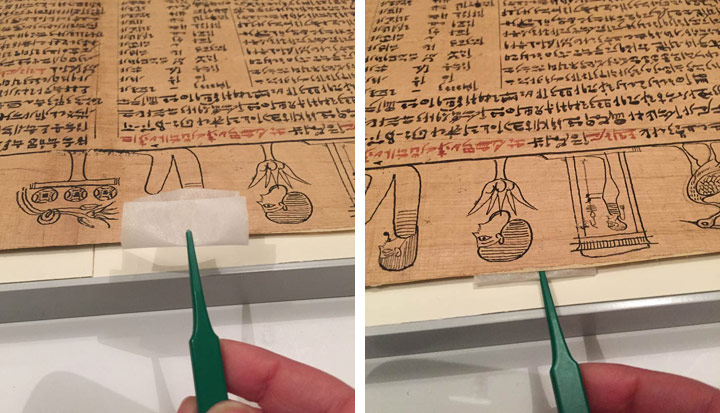
Left: A pasted up v-hinge. Right: The same v-hinge inserted under the papyrus. Photos by the author
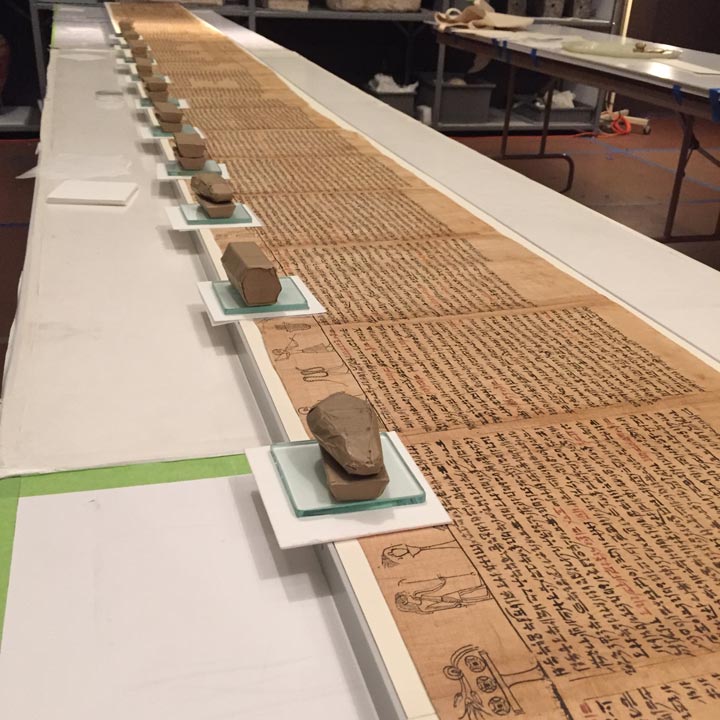
Hinges drying under the weights. Photo by the author
Spending a lot of quality time with this scroll, I had the
opportunity to closely observe aspects of how it was constructed and how
it has been treated in the more than 2000 years since it was made. To
make papyrus scrolls, the ancient Egyptians joined relatively square,
blank sections of the double-layered papyrus sheets with small overlaps,
using an adhesive that was likely starch based. Later on, mainly in the
early 20th century, collectors cut and fit sections of scrolls together
to straighten it out over its length (long scrolls tend to curve when
laid out), to facilitate easier storage, or to lose blank sections. Many
of these types of splices and adjustments can be seen on the Book of the Dead if one looks closely.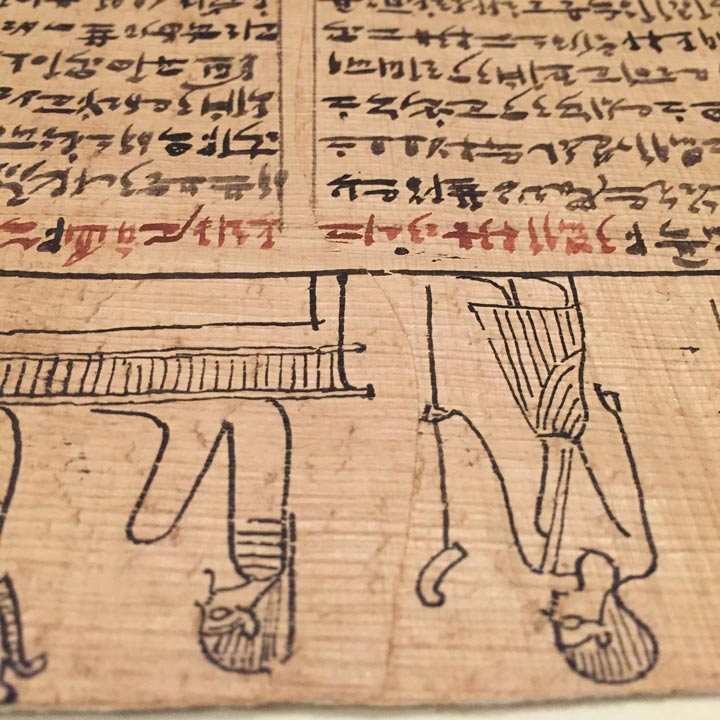
A curved, vertical cut that moves around the
script and illustrations and joins two segments together that were not
originally this close to each other. Photo by the author
Another important part of this project was documentation. As
mentioned earlier, not having proper documentation of the mounting and
condition of the scrolls was a major obstacle in planning for their
rehousing. In the future, Met paper conservators will have my
documentation of the scrolls' condition, treatment, and housing, which
the field of conservation considers essential to informed decision
making and preservation strategizing.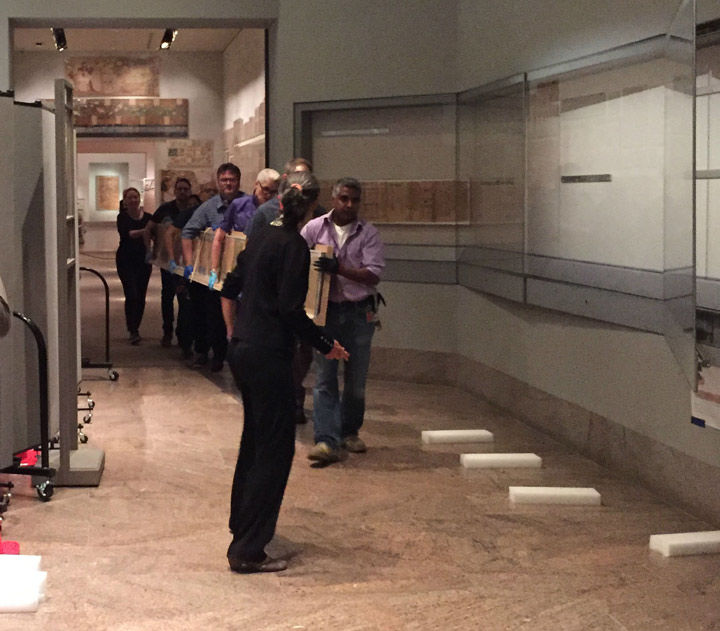
A procession of techs carrying the first long papyrus section to the new case. Photo by the author
After mounting and framing up all of the sections, it was finally
time to reinstall the scroll in the new cases. As was true for almost
every step of this project, the reinstallation required attentive
teamwork—this time, of technicians from all over the Museum. We watched
nervously as they expertly guided the frames into place, and when the
last frame was slipped onto its cleat, we all took a moment to
celebrate! 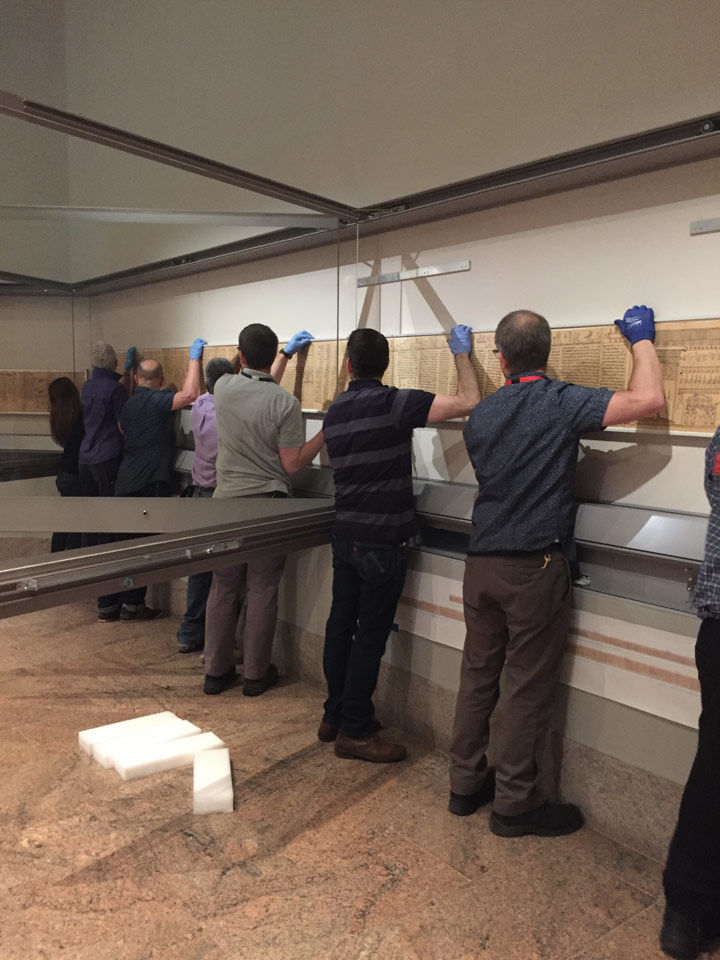
A section of the papyrus being installed on wall-mounted cleats. Photo by the author
With the reopening of the Ptolemaic galleries, visitors will be able
to appreciate this object more than ever before due to its improved
hanging height, lighting, closer viewing distance, and non-reflective
glazing. Most importantly, with the improvements made to the scroll's
preservation, this appreciation can be extended even further into the
future, and that is our deepest responsibility to our collection and
visitors.Related Link
See all posts related to the new installation of the galleries for Egyptian Ptolemaic art.
No comments:
Post a Comment